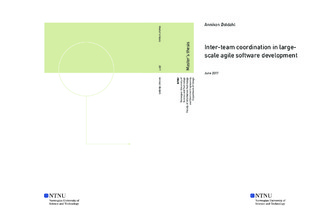| dc.description.abstract | Agile approaches for software development have increased in popularity since the formulation of the Agile Manifesto in 2001. The methods were initially developed for small teams to be able to respond quickly to change and to be flexible in the development process. Many have also seen the benefits of close customer collaboration and having self-empowered teams. In the latest years, agile practices have also caught interest in larger organisations, to whether it can be applied to large-scale software development projects as well. However, the theoretical grounding for agile in large-scale is still limited.
As projects increase in size, there will be more teams and team members, which lead to increased complexity that urges the need for more coordination than in smaller agile projects. Inter-team coordination has thereby been identified as an important research topic within large-scale agile software development.\\
In this master thesis, inter-team coordination has been studied through an exploratory case study, on a very-large scale agile software development project, which was conducted in Norway. The data from this case were analysed with the Van de Ven model of coordination.
The primary results of this master thesis support many principles of the Van de Ven model of coordination. There are influential factors to coordination that demand different coordination mechanisms, and it was experienced in the analysed case, that these mechanisms and arenas for coordination changed over time. From more standardised, plan-based and formal coordination in the beginning, to be more informal and horizontal as the project progressed. The informal communication was seen essential to ease the inter-team coordination, by being able to make clarifications at lower levels. This was first possible when relations and trust, across the teams, were built. Another interesting finding was that large-scale projects need, to some extent, more standardisation and structure than smaller agile projects. However, the difficulty is to find the right balance, so the agility is not lost. | |

